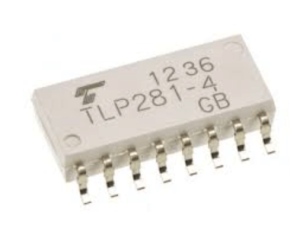
Optocoupler Integrated Circuits ( ICs) , also known as optoisolators , are critical components in modern electronics, enabling safe signal transmission between electrically isolated circuits. By using light as a medium, they prevent high-voltage surges, noise, and ground loops from damaging sensitive components. This guide explores their working principles, types, applications, and selection criteria.
Table of Contents
ToggleWhat is an Optocoupler?
An optocoupler is a semiconductor device that transfers electrical signals using light. It consists of two main parts:
- Input Side: An infrared LED that emits light when energized.
- Output Side: A photosensitive component (e.g., phototransistor, photodiode) that detects the light and generates a corresponding electrical signal.
The input and output are separated by a transparent insulating barrier, providing galvanic isolation (typically rated from 1 kV to 10 kV).
Working Principle
- Signal Input: A voltage applied to the LED causes it to emit light.
- Optical Transmission: Light crosses the insulating barrier.
- Signal Output: The photosensitive component converts light back into an electrical signal.
- Isolation: No electrical connection exists between input and output, protecting low-voltage circuits.
Internal Structure and Types
Optocouplers vary based on their output-side components:
1. Phototransistor Optocouplers
- Use a bipolar transistor to detect light.
- Moderate speed and current transfer ratio (CTR).
- Common in digital signal isolation (e.g., microcontroller interfaces).
2. Photodarlington Optocouplers
- Pair a phototransistor with a Darlington amplifier for higher gain.
- Slower response but higher sensitivity.
3. Photo-SCR/Photo-TRIAC Optocouplers
- Use silicon-controlled rectifiers (SCRs) or TRIACs for AC power control.
- Ideal for switching AC loads (e.g., dimmers, motor controllers).
4. High-Speed Optocouplers
- Combine photodiodes with integrated amplifiers for speeds up to 50 Mbps.
- Used in communication systems (e.g., USB isolation, Ethernet).
5. Solid-State Relays (SSRs)
- Optocouplers with power MOSFETs or TRIACs for switching high loads.
- Replace mechanical relays in industrial automation.
Key Parameters
When selecting an optocoupler, consider these specifications:
- Isolation Voltage: Maximum voltage the barrier can withstand (e.g., 5 kV).
- Current Transfer Ratio (CTR): Ratio of output current (ICIC) to input current (IFIF), expressed as CTR=ICIF×100%CTR=IFIC×100%. Higher CTR improves efficiency.
- Response Time: Delay between input activation and output response (critical for high-speed applications).
- Input Forward Current (IFIF): Typical LED drive current (5–20 mA).
- Output Saturation Voltage: Voltage drop across the output transistor when fully on.
Applications
- Power Supplies: Isolate feedback loops in switch-mode power supplies (SMPS).
- Industrial Controls: Protect PLCs from motor drive noise.
- Medical Equipment: Ensure patient safety in devices like ECG monitors.
- Consumer Electronics: Isolate USB/RS-232 interfaces.
- Automotive Systems: Isolate EV battery management systems.
Selection Criteria
- Voltage Requirements: Match isolation voltage to application needs.
- Speed: Choose high-speed optocouplers for data communication.
- CTR: Opt for photodarlingtons in low-input-current scenarios.
- Package: DIP, surface-mount, or compact packages for space-constrained designs.
Advantages vs. Limitations
| Advantages | Limitations |
|---|---|
| Galvanic isolation | LED degradation over time |
| Noise immunity | Limited bandwidth (<50 MHz) |
| Compact size | Higher power consumption (LED) |
Future Trends
- Higher Speed: Integration with silicon photonics for GHz-range signals.
- Improved Longevity: Advanced materials to reduce LED aging.
- Smart Features: Built-in diagnostics and fault detection.
Conclusion
Optocoupler ICs are indispensable for safe signal transmission in high-voltage environments. By understanding their types, parameters, and applications, engineers can design robust systems across industries. As technology evolves, optocouplers will continue to play a vital role in enabling smarter, safer electronics.
- Everything You Need To Know About Limit Switch - May 21, 2025
- Everthing You Should Know About Rheostat - May 20, 2025
- Everything You Need To Know About Reversing Contactor - May 19, 2025






